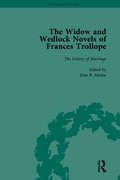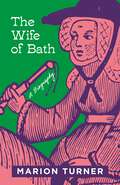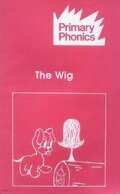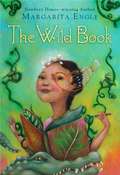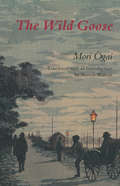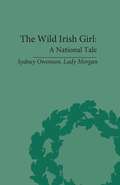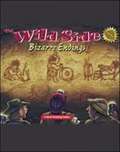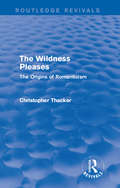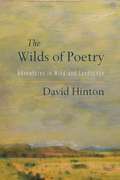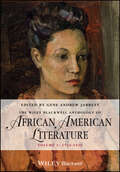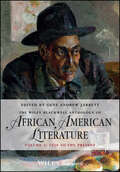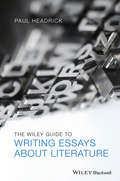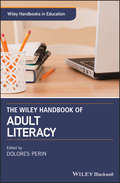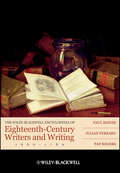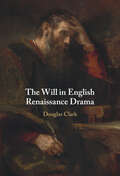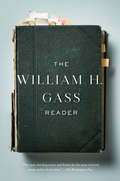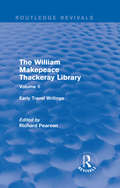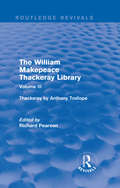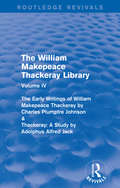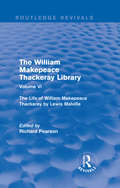- Table View
- List View
The Widow and Wedlock Novels of Frances Trollope Vol 4
by Brenda Ayres Tamara S Wagner Ann-Barbara Graff Abigail Burnham Bloom Elsie B MichieThe writings of Frances Trollope have been subject to increasing academic interest in recent years, and are now widely studied. In this four-volume set her comical, yet subversive, treatment of Victorian marriage provides an interesting contrast to some of the more earnest but conventional fiction of the time.
The Wife of Bath
by Geoffrey Chaucer Peter G. BeidlerThis edition is intended to help instructors in a variety of courses introduce their students to contemporary critical approaches to reading literature. Perhaps most usefully, it can serve as a supplement in the Chaucer course, alongside complete editions of Chaucer's works such as the Riverside Chaucer, or in more general introductory courses in medieval literature. It may also help instructors teaching the general survey course in English literature who wish to introduce critical perspectives right away, when students are reading medieval literature.
The Wife of Bath: A Biography
by Marion TurnerFrom the award-winning biographer of Chaucer, the story of his most popular and scandalous character, from the Middle Ages to #MeTooEver since her triumphant debut in Chaucer&’s Canterbury Tales, the Wife of Bath, arguably the first ordinary and recognisably real woman in English literature, has obsessed readers—from Shakespeare to James Joyce, Voltaire to Pasolini, Dryden to Zadie Smith. Few literary characters have led such colourful lives or matched her influence or capacity for reinvention in poetry, drama, fiction, and film. In The Wife of Bath, Marion Turner tells the fascinating story of where Chaucer&’s favourite character came from, how she related to real medieval women, and where her many travels have taken her since the fourteenth century, from Falstaff and Molly Bloom to #MeToo and Black Lives Matter.A sexually active and funny working woman, the Wife of Bath, also known as Alison, talks explicitly about sexual pleasure. She is also a victim of domestic abuse who tells a story of rape and redemption. Formed from misogynist sources, she plays with stereotypes. Turner sets Alison&’s fictional story alongside the lives of real medieval women—from a maid who travelled around Europe, abandoned her employer, and forged a new career in Rome to a duchess who married her fourth husband, a teenager, when she was sixty-five. Turner also tells the incredible story of Alison&’s post-medieval life, from seventeenth-century ballads and Polish communist pop art to her reclamation by postcolonial Black British women writers.Entertaining and enlightening, funny and provocative, The Wife of Bath is a one-of-a-kind history of a literary and feminist icon who continues to capture the imagination of readers.
The Wig (Primary Phonics Storybook #Set 1 Book 10)
by Barbara W. MakarA systematic, phonics-based early reading program that includes: the most practice for every skill, decodable readers for every skill, and reinforcement materials--help struggling students succeed in the regular classroom
The Wild Book
by Margarita EngleFefa struggles with words. She has word blindness, or dyslexia, and the doctor says she will never read or write. Every time she tries, the letters jumble and spill off the page, leaping and hopping away like bullfrogs. How will she ever understand them? But her mother has an idea. She gives Fefa a blank book filled with clean white pages. "Think of it as a garden," she says. Soon Fefa starts to sprinkle words across the pages of her wild book. She lets her words sprout like seedlings, shaky at first, then growing stronger and surer with each new day. And when her family is threatened, it is what Fefa has learned from her wild book that saves them.
The Wild Goose (Michigan Monograph Series in Japanese Studies #14)
by Ogai Mori Mori OgaiMori Ogai (1862–1922), one of the giants of modern Japanese literature, wrote The Wild Goose at the turn of the century. Set in the early 1880s, it was, for contemporary readers, a nostalgic return to a time when the nation was embarking on an era of dramatic change. Ogai’s narrator is a middle-aged man reminiscing about an unconsummated affair, dating to his student days, between his classmate and a young woman kept by a moneylender. At a time when writers tended to depict modern, alienated male intellectuals, the characters of The Wild Goose are diverse, including not only students preparing for a privileged intellectual life and members of the plebeian classes who provide services to them, but also a pair of highly developed female characters. The author’s sympathetic and penetrating portrayal of the dilemmas and frustrations faced by women in this early period of Japan’s modernization makes the story of particular interest to readers today. Ogai was not only a prolific and popular writer, but also a protean figure in early modern Japan: critic, translator, physician, military officer, and eventually Japan’s Surgeon General. His rigorous and broad education included the Chinese classics as well as Dutch and German; he gained admittance to the Medical School of Tokyo Imperial University at the age of only fifteen. Once established as a military physician, he was sent to Germany for four years to study aspects of European medicine still unfamiliar to the Japanese. Upon his return, he produced his first works of fiction and translations of English and European literature. Ogai’s writing is extolled for its unparalleled style and psychological insight, nowhere better demonstrated than in The Wild Goose.
The Wild Irish Girl (Pickering Women's Classics)
by Claire Connolly Stephen CopleyThis novel intervenes in many of the literary and philosophical debates of the late eighteenth century and early nineteenth century, forging a connection between the eighteenth-century discourse of sentiment and the emergent nineteenth-century concept of the nation. Lady Morgan's Introductory Letters are included.
The Wild Side: Angry Animals
by Henry Billings Melissa BillingsThe articles in this book spotlight the awesome powers of animals, powers that are unleashed when animals are angry or frightened or simply acting from instinct.
The Wild Side: Bizarre Endings (The\wild Side)
by Henry Billings Melissa BillingsStimulate reading excitement with nonfiction crafted for middle-level readability <li>This best-selling series motivates with high-interest selections at middle-level readability <li>Emphasis is on reading nonfiction <li>Critical thinking questions prepare students for state and national tests <P><P>The Wild Side, a perennial favorite among struggling readers, mesmerizes with astonishing tales of true-life adventures. One appreciative teacher notes: "I have difficulty removing the books from their hands at the end of the period!" Comprehension questions reinforce literal understanding, while critical thinking questions encourage students to consider the author's purpose, make inferences, identify cause and effect, and make predictions. With all this excitement, students won't realize how well designed this series is for reinforcing state reading standards. <li>Reading Level 4-6 <li>Interest Level 6-12
The Wild Side: Total Panic
by Henry Billings Melissa Billings Glencoe McGraw-Hill Staff Jamestown Publishers StaffThe Wild Side features amazing, strange, and unbelievable nonfiction selections that students will want to read. Each book includes new exercises and activities that improve reading comprehension and critical thinking skills.
The Wild Wood Enquiry
by Ann PurserIn a brand-new mystery from the author of The Measby Murder Enquiry, the cantankerous golden years gumshoe Ivy Beasley keeps her mental faculties sharp with a strict regimen of crime detection. Apart from the unwelcome noise made by the morning cleaning crew, life has been quiet at Springfields Home for the Elderly. Too quiet, in fact. Ivy and her team of sleuths, Enquire Within, have resorted to finding lost cats, and Gus is even threatening to return to his memoirs. But no sooner does he attempt to put a winning phrase together than he receives a call from his ex-wife, Katherine, who is in desperate needs of a place to hide. Though Gus has a difficult time getting a straight answer from Kath--just as it was in their many years of marriage--something is most certainly afoot, and soon Enquire Within is back in business. This time they have their hands full, not only with missing pets, but missing jewels, and evidence of foul play uncomfortably close to their too quiet home...
The Wildness Pleases (Routledge Revivals): The Origins of Romanticism
by Christopher ThackerFirst published in 1983. This book charts the growth of Romanticism from the initial reactions to the authoritarian classicism of Louis XIV, through the ‘codification’ of the Sublime by Burke in the 1750s, to the fascination with mystery, fear and violence which dominated the writing of the late eighteenth century. The origins of the movement are found in the writings of Rousseau and admiration for the ‘noble savage’, the development of the landscape garden, discoveries in the South Seas, new approaches to ‘primitive’ poetry and enthusiasm for gothic art and literature. These attitudes are contrasted with the more classical views of writers like Samuel Johnson.
The Wilds of Poetry: Adventures in Mind and Landscape
by David HintonAn exploration of the emerging Western consciousness of how deeply we belong to the wild Cosmos, as seen through the lineage of modern America's great avant-garde poets --a thrilling journey with today's premier translator of the Chinese classics.Henry David Thoreau, in The Maine Woods, describes a moment on Mount Ktaadin when all explanations and assumptions fell away for him and he was confronted with the wonderful, inexplicable thusness of things. David Hinton takes that moment as the starting point for his account of a rewilding of consciousness in the West: a dawning awareness of our essential oneness with the world around us. Because there was no Western vocabulary for this perception, it fell to poets to make the first efforts at articulation, and those efforts were largely driven by Taoist and Ch’an (Zen) Buddhist ideas imported from ancient China. Hinton chronicles this rewilding through the lineage of avant-garde poetry in twentieth-century America—from Walt Whitman, Ezra Pound and Robinson Jeffers to Gary Snyder, W. S. Merwin, and beyond—including generous selections of poems that together form a compelling anthology of ecopoetry. In his much-admired translations, Hinton has re-created ancient Chinese rivers-and-mountains poetry as modern American poetry; here, he reenvisions modern American poetry as an extension of that ancient Chinese tradition: an ecopoetry that weaves consciousness into the Cosmos in radical and fundamental ways.
The Wiley Blackwell Anthology of African American Literature, Volume 1: 1746 - 1920 (Blackwell Anthologies)
by Gene Andrew JarrettThe Wiley Blackwell Anthology of African American Literature is a comprehensive collection of poems, short stories, novellas, novels, plays, autobiographies, and essays authored by African Americans from the eighteenth century until the present. Evenly divided into two volumes, it is also the first such anthology to be conceived and published for both classroom and online education in the new millennium. Reflects the current scholarly and pedagogic structure of African American literary studies Selects literary texts according to extensive research on classroom adoptions, scholarship, and the expert opinions of leading professors Organizes literary texts according to more appropriate periods of literary history, dividing them into seven sections that accurately depict intellectual, cultural, and political movements Includes more reprints of entire works and longer selections of major works than any other anthology of its kind This first volume contains a comprehensive collection of texts authored by African Americans from the eighteenth century until the 1920s The two volumes of this landmark anthology can also be bought as a set, at over 20% savings.
The Wiley Blackwell Anthology of African American Literature, Volume 2: 1920 to the Present (Blackwell Anthologies)
by Gene Andrew JarrettThe Wiley Blackwell Anthology of African American Literature is a comprehensive collection of poems, short stories, novellas, novels, plays, autobiographies, and essays authored by African Americans from the eighteenth century until the present. Evenly divided into two volumes, it is also the first such anthology to be conceived and published for both classroom and online education in the new millennium. Reflects the current scholarly and pedagogic structure of African American literary studies Selects literary texts according to extensive research on classroom adoptions, scholarship, and the expert opinions of leading professors Organizes literary texts according to more appropriate periods of literary history, dividing them into seven sections that accurately depict intellectual, cultural, and political movements Includes more reprints of entire works and longer selections of major works than any other anthology of its kind This second volume contains a comprehensive collection of texts authored by African Americans from the 1920s to the present The two volumes of this landmark anthology can also be bought as a set, at over 20% savings.
The Wiley Blackwell Companion to Contemporary British and Irish Literature (Blackwell Companions to Literature and Culture)
by James Ward Stephen Butler Madelena Gonzalez Kevin De OrnellasTHE WILEY BLACKWELL COMPANION TO CONTEMPORARY BRITISH AND IRISH LITERATURE An insightful guide to the exploration of modern British and Irish literature The Wiley Blackwell Companion to Contemporary British and Irish Literature is a must-have guide for anyone hoping to navigate the world of new British and Irish writing. Including modern authors and poets from the 1960s through to the 21st century, the Companion provides a thorough overview of contemporary poetry, fiction, and drama by some of the most prominent and noteworthy writers. Seventy-three comprehensive chapters focus on individual authors as well as such topics as Englishness and identity, contemporary Science Fiction, Black writing in Britain, crime fiction, and the influence of globalization on British and Irish Literature. Written in four parts, The Wiley Blackwell Companion to Contemporary British and Irish Literature includes comprehensive examinations of individual authors, as well as a variety of themes that have come to define the contemporary period: ethnicity, gender, nationality, and more. A thorough guide to the main figures and concepts in contemporary literature from Britain and Ireland, this two-volume set: Includes studies of notable figures such as Seamus Heaney and Angela Carter, as well as more recently influential writers such as Zadie Smith and Sarah Waters. Covers topics such as LGBT fiction, androgyny in contemporary British Literature, and post-Troubles Northern Irish Fiction Features a broad range of writers and topics covered by distinguished academics Includes an analysis of the interplay between individual authors and the major themes of the day, and whether an examination of the latter enables us to appreciate the former. The Wiley Blackwell Companion to Contemporary British and Irish Literature provides essential reading for students as well as academics seeking to learn more about the history and future direction of contemporary British and Irish Literature.
The Wiley Guide to Writing Essays About Literature
by Paul HeadrickThis outstanding practical guide to writing analytical essays on literature develops interpretive skills through focused exercises and modeled examples. The program is tailored to meet the specific needs of beginning undergraduates.Features unique, detailed guidance on paragraph structureIncludes sample essays throughout to model each stage of the essay-writing processFocused exercises develop the techniques outlined in each chapterDedicated checklists enable quick, accurate assessment by teachers and studentsEnhanced glossary with advice on usage added to core definitions
The Wiley Handbook of Adult Literacy (Wiley Handbooks in Education)
by Dolores PerinExamines the widespread phenomenon of poor literacy skills in adults across the globe This handbook presents a wide range of research on adults who have low literacy skills. It looks at the cognitive, affective, and motivational factors underlying adult literacy; adult literacy in different countries; and the educational approaches being taken to help improve adults’ literacy skills. It includes not only adults enrolled in adult literacy programs, but postsecondary students with low literacy skills, some of whom have reading disabilities. The first section of The Wiley Handbook of Adult Literacy covers issues such as phonological abilities in adults who have not yet learned to read; gender differences in the reading motivation of adults with low literacy skills; literacy skills, academic self-efficacy, and participation in prison education; and more. Chapters on adult literacy, social change and sociocultural factors in South Asia and in Ghana; literacy, numeracy, and self-rated health among U.S. adults; adult literacy programs in Southeastern Europe and Turkey, and a review of family and workplace literacy programs are among the topics featured in the second section. The last part examines how to teach reading and writing to adults with low skills; adults’ transition from secondary to postsecondary education; implications for policy, research, and practice in the adult education field; educational technologies that support reading comprehension; and more. Looks at the cognitive processing challenges associated with low literacy in adults Features contributions from a global team of experts in the field Offers writing strategy instruction for low-skilled postsecondary students The Wiley Handbook of Adult Literacy is an excellent book for academic researchers, teacher educators, professional developers, program designers, and graduate students. It’s also beneficial to curriculum developers, adult basic education and developmental education instructors, and program administrators, as well as clinicians and counselors who provide services to adults with reading disabilities.
The Wiley-Blackwell Encyclopedia of Eighteenth-Century Writers and Writing 1660 - 1789
by Pat Rogers Julian Ferraro Paul BainesThe Wiley-Blackwell Encyclopedia of Eighteenth-Century Writers and Writing1660-1789 features coverage of the lives and works of almost 500 notable writers based in the British Isles from the return of the British monarchy in 1660 until the French Revolution of 1789. Broad coverage of writers and texts presents a new picture of 18th-century British authorship Takes advantage of newly expanded eighteenth-century canon to include significantly more women writers and labouring-class writers than have traditionally been studied Draws on the latest scholarship to more accurately reflect the literary achievements of the long eighteenth century
The Will in English Renaissance Drama
by Douglas ClarkDouglas Clark reveals how moments of willing and will-making pervade English Renaissance drama and play a crucial role in the depiction of selfhood, sin, sociality, and succession. This wide-ranging study synthesizes concepts from historical, legal, philosophical, and theological studies to examine the dramatic performance of the will as both an internal faculty and a legal document. Clark establishes the diverse connections that Shakespeare, Jonson, Middleton, and a range of overlooked playwrights of the early Elizabethan era made between different types and understandings of the will. By doing so, he reveals the little-understood ethical issues to which they gave rise in relation to the mind, emotions, and soul. Understanding the purpose of the will in its multiple forms was a central concern for writers of the time, and Clark shows how this concern profoundly shaped the depiction of life and death in both Elizabethan and Jacobean drama. This title is part of the Flip It Open programme and may also be available as open access. Check our website Cambridge Core for details.
The William H. Gass Reader
by William H. GassA literary delight--a reading feast; a Gassian celebration--the best of the best: more than fifty selections chosen by Gass himself from his essays, criticism, commentary, short stories, and novels.It begins with his essays, in which Gass looks back at varying points in his writing life at those writers (from Plato, Hobbes, and James, to Joyce, Beckett, Stein, and Gaddis) whose work he found inspiring . . . and at those whose work he explores and embraces (Laurence Sterne's Tristram Shandy; Ford Madox Ford's Parade's End; Thomas Mann's The Magic Mountain; Stendhal's The Red and the Black). He writes (from A Temple of Texts) on the nature and value of writing ("The true alchemists do not change lead into gold; they change the world into words"). Here is a rich experience of Gass's short fiction: from Eyes, his masterfully crafted novella, "In Camera," about collecting, hording; about suspicions run amok . . . from Cartesian Sonata . . . and In the Heart of the Heart of the Country (1968), a mythical reimagining of America's heartland. And from his nimble, daredevil novels: Middle C (2013), the chronicle of an Austrian-born man who, as a child with his mother, relocates to America's Midwest (Woodbine, Ohio), grows up a low-skilled amateur piano player to become a music professor at a small Bible college; his only hobby a fantasy life as the curator of his Inhumanity Museum . . . and from The Tunnel ("The most beautiful, most complex, most disturbing novel to be published in my lifetime" --Michael Silverblatt, Los Angeles Times).
The William Makepeace Thackeray Library: Volume II - Early Travel Writings (Routledge Revivals: The William Makepeace Thackeray Library)
by Richard PearsonFirst published in 1996, The William Makepeace Thackeray Library is a collection of works written by and about the novelist. William Makepeace Thackeray spent part of virtually every year of his writing life in Paris and he wrote continually on France and French culture. This volume contains a selection of Thackeray’s travel writing, the majority of which centres around his time spent in France, with the addition of some writing on his travels to Germany and America. With an explanatory introduction by Richard Pearson, this book reveals some of Thackeray’s lesser-known work which would later inform his novels. This book will be of interest to those studying Thackeray and nineteenth-century travel writing and literature.
The William Makepeace Thackeray Library: Volume III - Thackeray by Anthony Trollope (Routledge Revivals: The William Makepeace Thackeray Library)
by Anthony Trollope and Richard PearsonFirst published in 1996, The William Makepeace Thackeray Library is a collection of works written by and about the novelist. This third volume contains Anthony Trollope’s volume on Thackeray from John Morley’s series entitled The English Men of Letters. The work signifies Thackeray’s move to perceived respectability, placing him as part of the literary establishment, alongside writers such as Spenser, Johnson, Milton, Chaucer, Pope and Wordsworth. The introduction by Richard Pearson outlines the context in which the volume was written and received, including Trollope and Thackeray’s relationship and the book’s critical reception. This book will be of interest to those studying Thackeray and nineteenth-century literature.
The William Makepeace Thackeray Library: Volume IV - The Early Writings of William Makepeace Thackeray by Charles Plumptre Johnson & Thackeray: A Study by Adolphus Alfred Jack (Routledge Revivals: The William Makepeace Thackeray Library #4)
by Richard PearsonFirst published in 1996, The William Makepeace Thackeray Library is a collection of works written by and about the novelist. This fourth volume contains Charles Plumptre Johnson’s The Early Writings of William Makepeace Thackeray and Adolphus Alfred Jack’s Thackeray: A Study. While Johnson’s work signifies a landmark in Thackeray scholarship, recognizing his lesser-known work for magazines and newspapers, A. A. Jack’s text marks a major reassessment of Thackeray’s work in light of the debate on the moral intentionality of fiction. Richard Pearson’s introduction guides the reader through the context of each publication, providing a helpful explanation of how and why these works were written. This book will be of interest to those studying Thackeray and nineteenth-century literature.
The William Makepeace Thackeray Library: Volume VI - The Life of William Makepeace Thackeray by Lewis Melville (Routledge Revivals: The William Makepeace Thackeray Library)
by Richard PearsonFirst published in 1996, The William Makepeace Thackeray Library is a collection of works written by and about the novelist. This sixth volume contains the work of Lewis Melville, one of the most productive biographers and critics of Thackeray at the turn of the 20th century. Richard Pearson’s helpful introduction not only provides additional information on the biographer himself, but also analyses the text and tracks its development over time. This book will be of interest to those studying Thackeray and nineteenth-century literature.
